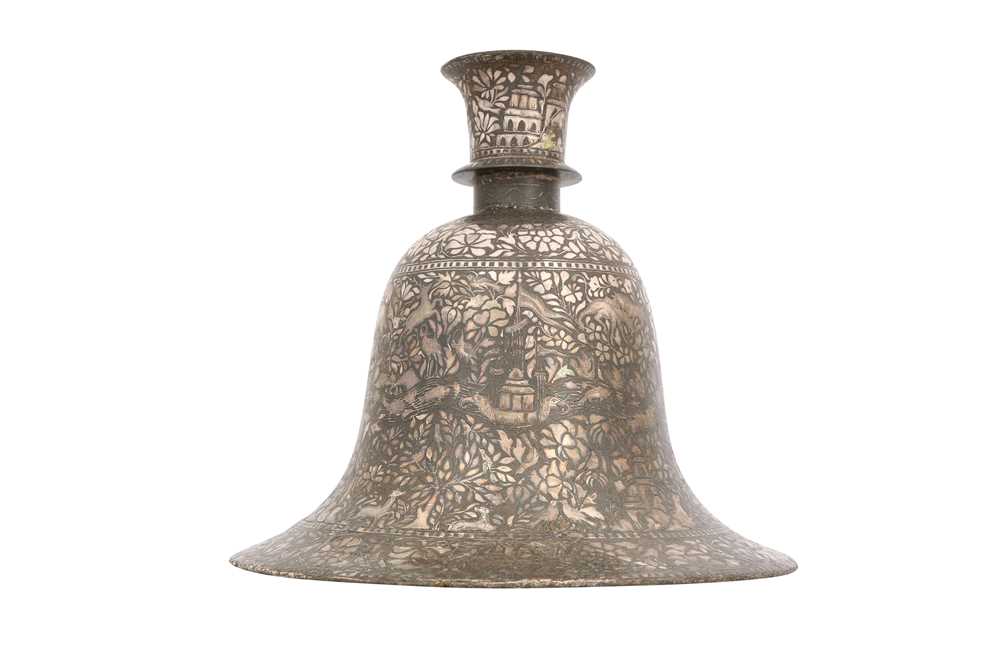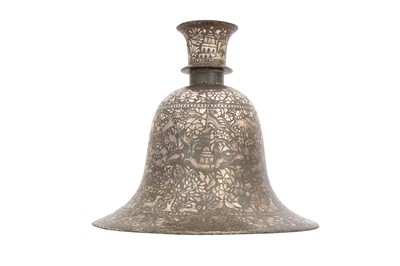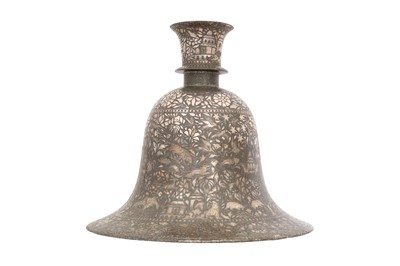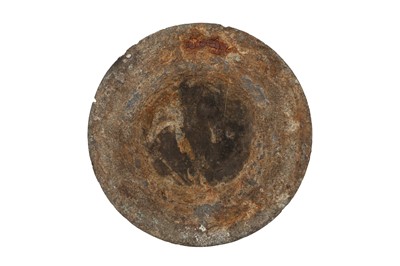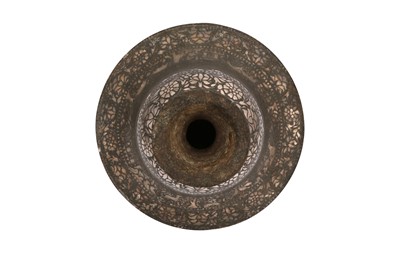29th Apr, 2022 11:00
Islamic Art - Property of a European Collector Part III
A BIDRI SILVER-INLAID HUQQA BASE WITH SAILING VESSELS IN A RIVER AND WILD ANIMALS
Bidar, Deccan, Central India, mid to late 18th century
A BIDRI SILVER-INLAID HUQQA BASE WITH SAILING VESSELS IN A RIVER AND WILD ANIMALS
PROPERTY FROM AN IMPORTANT EUROPEAN PRIVATE COLLECTION
Bidar, Deccan, Central India, mid to late 18th century
Of typical bell-like shape, resting on a wide, circular, flat base, rising to narrow shoulders and a ringed cylindrical neck with gently everted rim, the exterior densely decorated with a detailed naturalistic riverside scene in silver inlay featuring a great variety of wild animals in various activities within a dense vegetal background, the river presented as a sinuous band crossing the middle of the body and animated by swans, jumping fishes, swimming elephants, stylised makaras, and three sailing vessels, each one identified by different animals featured on the aft and bow, three temples and architectural complexes depicted in the lower part of the body and repeated around the flared neck, the main decorative program of the body set between two friezes with interlocking and scrolling rosette and lotus flower sprays with abundant foliage, the base 24cm diam. and the huqqa 21cm high.
This huqqa base, previously offered at Sotheby's London, 24 April 2013, lot 201, is a very fine and remarkable example of the skills of Bidri craftsmen in the 18th century. Influenced and inspired by the vibrancy and dynamism of 17th and 18th-century Deccani paintings, especially Ragamala compositions, the decorative program on this water pipe base is a most accomplished one. In his research, Zebrowski attributes similarly decorated globular huqqas with original figural and architectural designs to a highly-skilled workshop - or perhaps even just a single talented craftsman - active in Bidar in the mid-17th century (M. Zebrowski, Gold, Silver and Bronze from Mughal India, 1997, pp. 229 - 232). The five pieces selected by the scholar as exquisite examples of unusual 17th-century Bidri work all feature lively animals, naturalistic lush vegetal motifs, and accurate representations of local architecture. Similar to contemporary paintings and to our lot, the division of the surface into water, earth, and sky evokes an ideal world in microcosm, an increasingly popular concept in the arts of India of the 17th and 18th centuries.
In the same publication, Zebrowksi affirms that the introduction of bell-shaped huqqa bases in the formal vocabulary of Bidri metalwork did not take place until the 1730s - 1740s, and it grew in popularity mostly in the second half of the 18th century (Ibidem, p. 236). Therefore, it is plausible to suggest that our huqqa base was probably produced in the mid-18th century as one of the first examples following the same style and decorative vocabulary of the innovative group of mid-17th century creations but applying it onto a completely new shape.
Do you have an item similar to the item above? If so please click the link below to submit a free online valuation request through our website.
